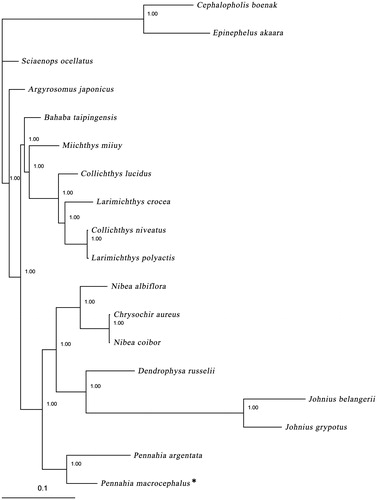Abstract
The complete mitogenome of the bighead pennah croaker Pennahia microcephalus was first determined in this study. It is 16,508 bp in length with the typical gene order and transcriptional direction in vertebrates containing 37 genes. The overall nucleotide composition is 27.5% A; 31.2% C; 16.0% G, and 25.3% T. The sizes of the 22 tRNA genes range from 68 to 75 bp. Two start (ATC and ATG) and three stop (AGA, TAG, and TAA/TA/T) codons were found in the protein-coding genes. In the Bayesian tree, all nodes were strongly supported based on the complete mitogenomes of 16 species from the family Sciaenidae. The phylogenetic results suggested P. macrocephalus has the closest relationship to the silver croaker P. argentata, a species from the same genus.
The family Sciaenidae (Perciformes), commonly known as croakers and drums, is an economically important group of fishes, comprising about 270 species in 70 genera in the world (Nelson Citation2006). The big-head pennah croaker Pennahia microcephalus is an Indo-West Pacific sciaenid species ranging from East and South China Seas to Java, Indonesia (Sasaki Citation2001). The species inhabits coastal water down to 100 m, and feeds on small invertebrates and fishes with maximum standard length of 23 cm. In this study, we presented the complete mitochondrial genome of P. macrocephalus and assessed its phylogenetic relationship based on another 15 available mitogenomes in the family Sciaenidae with 2 available mitogenomes in the family Epinephelidae as an outgroup.
One specimen of P. macrocephalus (PM20160425001) was collected by a bottom trawler in Pingtan Island, Fujian Province, China. The protocol and data analysis methods followed that illustrated by Chen et al. (Citation2014). The complete mitochondrial genome of P. macrocephalus is 16,508 bp in length (GenBank accession number: KX576460). It consists of 2 rRNA genes, 22 tRNA genes, 13 protein-coding genes, and 1 control region, with the typical gene order and direction of transcription in vertebrates. The overall nucleotide composition is as follows: 27.5% A; 31.2% C; 16.0% G, and 25.3% T. In the 13 identified protein-coding genes, 12 genes were initiated by the ATG codon except for ATP8 which was initiated by the ATC codon. Three stop codons (AGA, TAG, and TAA/TA/A) were found in the mitogenome of P. macrocephalus. The COX1 was terminated with AGA codon, ND5 and ND6 were terminated with TAG, and the other protein-coding genes were terminated by either TAA or incomplete codon T or TA that may form complete termination signal UAA via post-transcriptional polyadenylation (Ojala et al. Citation1981). The 12S (953 bp) and 16S (1703 bp) rRNA genes, located between the tRNA-Phe and tRNA-Leu1 genes, are separated by the tRNA-Val gene. The lengths of 22 tRNA genes range from 68 to 75 bp; 21 tRNAs can be folded into the typical cloverleaf secondary structures with the exception of tRNA-Ser2 in which the DHU arm was replaced by a simple loop. A 37 bp inserted sequence was identified as the putative origin of L-strand replication (OL). The control region was 821 bp in length with high A + T (62.7%) and poor G + C (37.3%) composition.
Published mitogenomes of all 16 species of the family Sciaenidae (including P. macrocephalus), and the chocolate hind Cephalopholis boenak and the Hong Kong grouper Epinephelus akaara from the family Epinephelidae were used to assess the phylogenetic relationship of P. macrocephalus. Phylogenetic tree was constructed with the partitioned Bayesian method based the dataset combined by three partitions (the alignments of the 1, 2 codon positions of 12 H-strand encoded protein-coding genes together with 2 rRNAs) under the GRT + I + G model (Ronquist & Huelsenbeck Citation2003). As the phylogenetic tree showed, all nodes were strongly supported with high value of posterior probability (). It proved that using the mitogenome for phylogenetic analysis is more convincing than using single gene or multiple genes. Pennahia macrocephalus was placed as sister to the silver croaker P. argentata, a species from the same genus, which is consistent to the croaker phylogenetic results using combined mitochondrial and nuclear genomes (Lo et al. Citation2015).
Figure 1. Phylogenetic positon of the bighead pennah croaker Pennahia microcephalus. Cephalopholis boenak (KC537759.1) and Epinephelus akaara (EU043377.1) were selected as the outgroup. The other 15 species from the family Sciaenidae are: Argyrosomus japonicas (NC_017610.1), Bahaba taipingensis (NC_018347.1), Chrysochir aureus (NC_016987.1), Collichthys lucidus (JN857362.1), Collichthys niveatus (HM219223.1), Dendrophysa russellii (NC_017606.1), Johnius belangerii (KF211426.1), Johnius grypotus (KC491206), Larimichthys crocea (NC_011710.1), Larimichthys polyactis (GU586227.1), Miichthys miiuy (NC_014351.1), Nibea albiflora (NC_015205.1), Nibea coibor (NC_025307.1), P. argentata (KC545800.1), and Sciaenops ocellatus (NC_016867.1).

Disclosure statement
The authors report no conflicts of interest. The authors alone are responsible for the content and writing of the paper.
References
- Chen X, Ai WM, Xiang D, Chen SB. 2014. Complete mitochondrial genome of the red stingray Dasyatisakajei (Myliobatiformes: Dasyatidae). Mitochondrial DNA. 25:37–38.
- Lo PC, Liu SH, Chao NL, Nunoo FKE, Mok HK, Chen WJ. 2015. A multi-gene dataset reveals a tropical New World origin and Early Miocene diversification of croakers (Perciformes: Sciaenidae). Mol Phylogen Evol. 88:132–143.
- Nelson JS. 2006. Fishes of the World. 4th ed. Hoboken (NJ): John Wiley & Sons, Inc.
- Ojala D, Montoya J, Attardi G. 1981. tRNA punctuation model of RNA processing in human mitochondria. Nature. 290:470–474.
- Ronquist F, Huelsenbeck JP. 2003. MrBayes 3: Bayesian phylogenetic inference under mixed models. Bioinformatics. 19:1572–1574.
- Sasaki K. 2001. Sciaenidae-Croakers (drums). In: Carpenter KE, Niem VH, editors. FAO species identification guide for fishery purposes. The living marine resources of the Western Central Pacific. Volume 5: Bony Fishes Part 3 (Menidae to Pomacentridae); Rome: FAO; p. 3169.
